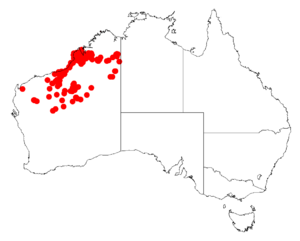Broome pindan wattle facts for kids
Quick facts for kids Broome pindan wattle |
|
|---|---|
| Scientific classification | |
| Genus: |
Acacia
|
| Species: |
eriopoda
|
 |
|
| Occurrence data from AVH | |
The Broome pindan wattle (Acacia eriopoda) is a type of wattle tree. It is also called the narrow-leaf pindan wattle. This plant belongs to the legume family. It grows naturally in northern Western Australia. The Nyangumarta people, who are Indigenous Australians, call it Yirrakulu.
Contents
What Does the Broome Pindan Wattle Look Like?
The Broome pindan wattle can be a tall shrub or a small tree. It usually grows between 2 to 8 meters (about 6 to 26 feet) high. It often has one main trunk. Sometimes, it has up to four straight stems growing from near its base.
Leaves and Flowers
This wattle has a light and airy look. Its bark is usually mid-grey to light grey. The bark is finely cracked along the main trunks and branches. Smaller branches have smoother bark.
The leaves are called phyllodes. They are green to grey-green and sometimes look a bit yellowish. These phyllodes are long and thin, like narrow blades. They are about 10 to 24 centimeters (4 to 9.5 inches) long. They are only 1 to 5 millimeters (less than a quarter inch) wide. They are mostly straight with many thin lines running along them.
The Broome pindan wattle produces bright yellow flowers. These flowers grow in spikes about 2.5 centimeters (1 inch) long. They are packed together tightly. You can see these flowers from April to September.
Seed Pods and Seeds
After the flowers bloom, long seed pods grow. These pods hang down and look like a string of beads. They are produced in large numbers. Each pod can be 6 to 20 centimeters (2.5 to 8 inches) long. They are about 3 to 4 millimeters (0.1 to 0.15 inches) wide.
When the pods are ripe, they are light brown. They are thin but tough. Inside, there are shiny black seeds. These seeds are oval-shaped and about 4 to 6.5 millimeters (0.15 to 0.25 inches) long. Each seed has a white aril, which is a small fleshy part.
How Was This Wattle Named?
Scientists officially described the Broome pindan wattle in 1927. Two botanists, Joseph Maiden and William Blakely, named it. They wrote about it in a scientific paper.
Changes to Its Name
For a short time in 2003, another botanist named Leslie Pedley changed its scientific name to Racosperma eriopodum. However, in 2006, it was moved back to the Acacia group. So, its official name is still Acacia eriopoda.
Meaning of the Name
The second part of its scientific name, eriopoda, comes from Greek words. "Erio-" means "wool," and "-poda" means "foot." This name refers to the short, hairy stalks (called pedicels) that hold the flowers.
Where Does the Broome Pindan Wattle Grow?
The Broome pindan wattle grows in many parts of Western Australia. It likes red sandy soils. You can find it in several IBRA bioregions. These include Carnarvon, Central Kimberley, Dampierland, Gascoyne, Great Sandy Desert, Little Sandy Desert, Ord Victoria Plain, Pilbara, and Tanami.
Its Habitat
This wattle is often found in areas called pindan habitats. Pindan is a type of woodland found in northern Australia. It is most common in the Kimberley region. Some populations are also in the Pilbara region.
In these areas, it grows along watercourses. It can also be found on low, rocky ranges. It prefers deep red sand and sandy soils on alluvial pindan plains.

